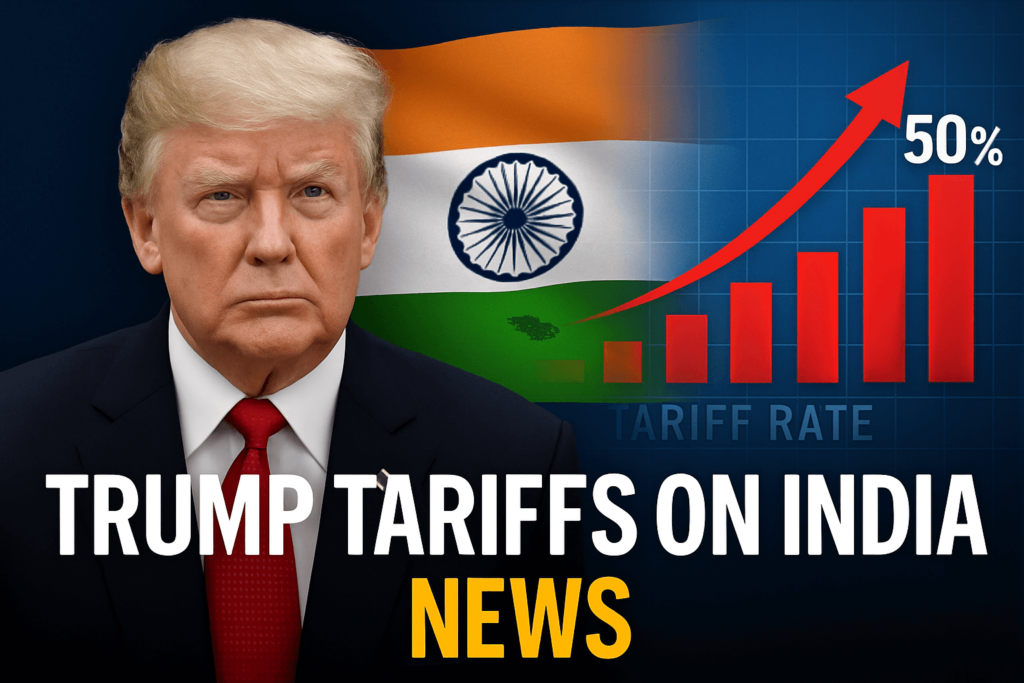Ever wonder why Donald Trump seems to be gunning for India lately? In the latest twist of global politics, Trump tariffs India is making headlines again—and not for the right reasons. The former and current Republican frontrunner (yes, he’s back in action) has slapped a massive 50% tariff on Indian imports, all because of India’s energy dealings with Russia.
But why single out India, especially when countries like China are doing the same? Why now? And what’s really at stake here?
Let’s break it all down in plain English, without the political mumbo jumbo.
Trump Tariffs India: What Happened?
On August 6, 2025, Trump signed an executive order imposing an additional 25% tariff on top of an existing 25% duty on Indian imports. That’s a whopping 50% tariff on India—a move that’s rattled not just New Delhi but also international trade circles.
His reasoning? India’s continued purchase of Russian oil, despite global pressure to isolate Moscow due to the ongoing Ukraine conflict.
The Press Asked “Why India?” – Trump’s Vague Reply
During a press conference, when a journalist asked why India was being singled out when others (ahem, China) are also buying Russian oil, Trump brushed it off.
“It’s only been 8 hours. So let’s see what happens. You’re going to see a lot more…so many secondary sanctions.”
So basically—he didn’t really answer. Classic Trump.
India Isn’t Taking It Lightly
New Delhi fired back immediately, calling the move:
“Unfair, unjustified, and unreasonable.”
India’s Ministry of External Affairs (MEA) didn’t hold back. They accused the U.S. of double standards, pointing out that Washington continues to import Russian uranium, palladium, and fertilizer, while penalizing India for oil.
The message? If the U.S. gets to fill its shopping cart in Russia, why can’t we?
Could This Break the US-India Bromance?
For the last two decades, India and the U.S. have been inching closer—strategic partners, military collaborations, joint space programs—you name it.
But Trump’s latest tariff on India could throw a wrench into all of that.
According to experts, this could be the tipping point. Ashley Tellis, a senior fellow at the Carnegie Endowment, warns:
“Modi may reduce oil purchases from Russia, but he can’t admit it. Doing so would look like he’s caving to Trump’s bullying.”
In short, it’s a political chess game with major consequences.
The Real Stakes Behind the Tariffs
Let’s be real—tariffs aren’t just about money. They’re a weapon of political pressure.
Trump wants Russia to sit down at the table and agree to a peace deal with Ukraine. And to force that, he’s threatening everyone who still does business with Moscow.
India just happens to be an easy (and politically juicy) target.
But the danger? According to Evan Feigenbaum, a former U.S. State Department official, India could become a political “football” in Washington’s domestic games—especially on issues like immigration, tech visas, and manufacturing.
Wait, What About China?
That’s the million-dollar question.
India’s been vocal: If this is about Russian oil, why not sanction China, who’s buying even more of it?
Trump hasn’t given a clear answer. But the underlying implication? India’s huge trade surplus with the U.S. and its growing tech sector make it a more convenient target than China—at least politically.
Energy Diplomacy or Economic Blackmail?
Let’s call it what it is—Trump is using energy purchases as leverage.
By hitting India with harsh tariffs, he’s pressuring PM Modi to pick a side. And it’s not subtle. In fact, Trump even made a jab that India could “buy oil from Pakistan instead”—which obviously didn’t go down well in New Delhi.
That’s like telling a Red Sox fan to root for the Yankees. Just… no.
Is This the Start of a Bigger Trade War?
Possibly. India has already vowed to take “all necessary actions” to protect its national interests. And that could mean countermeasures—like tariffs on U.S. products, boycotts, or strengthening alliances elsewhere (say, with the EU or BRICS nations).
Once this tit-for-tat starts, it rarely stops.
What Experts Are Saying
Let’s break down some quick insights from the top minds:
-
Ashley Tellis: Warns of a political trap where India can’t back down without losing face.
-
Evan Feigenbaum: Believes India could become a pawn in America’s domestic politics.
-
Indian MEA: Calls the U.S. out for hypocrisy.
-
Shashi Tharoor (Indian MP): Has criticized Trump’s foreign policy moves in the past, calling them “erratic” and “short-sighted.”
So yeah, there’s a lot of smoke—and likely some fire, too.
What Does This Mean for Everyday Indians & Americans?
If you’re wondering how this affects you, here’s the short version:
-
Indian exporters to the U.S. (think tech, textiles, pharma) may see major slowdowns.
-
American companies relying on Indian supply chains (software, call centers, etc.) might feel the pinch.
-
Prices could rise on certain goods, especially if retaliatory tariffs are imposed.
-
Geopolitical tension could spill over into other sectors—like visas, immigration, and defense partnerships.
So, What Now?
It’s too early to say how this will play out. Trump’s style is high-pressure and unpredictable. But one thing’s for sure—the trump tariffs india drama is far from over.
India is caught between staying true to its own foreign policy and navigating Trump’s tariff tantrum. The next few weeks will tell us whether cooler heads will prevail or whether we’re heading for a full-blown diplomatic face-off.
Read More: Raksha Bandhan 2025: Zodiac Signs That Must Perform Remedies to Avoid Bad Luck
Conclusion
At the heart of it, this isn’t just about oil or trade. It’s about power, politics, and perception. Trump wants to be seen as tough on Russia—and punishing India helps him flex that muscle.
But if diplomacy dies in the crossfire, both nations stand to lose. Big time.
The clock is ticking. Will India give in? Will Trump double down? Or will both sides find a way back to the table?







[…] Read More: Trump Tariffs India: Why New Delhi Just Became Washington’s Favorite Target […]